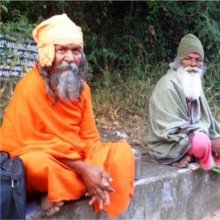Palani, Pālanī, Pazhani: 7 definitions
Introduction:
Palani means something in Hinduism, Sanskrit, the history of ancient India, Marathi, Tamil. If you want to know the exact meaning, history, etymology or English translation of this term then check out the descriptions on this page. Add your comment or reference to a book if you want to contribute to this summary article.
Images (photo gallery)
(+4 more images available)
In Hinduism
Shilpashastra (iconography)
Source: Shodhganga: The significance of the mūla-beras (śilpa)Palani Āṇṭavar is the name of deity as found depicted in the Meenakshi Temple in Madurai (or Madura), which represents a sacred place for the worship of The Goddess (Devī).—Palani Āṇṭavar or Murukan is represented with two hands where the right hand is in kaṭaka-hasta (cenkol) and the left hand is in kaṭyavalambita-hasta. He is found in the standing posture named vaiśākha posture. With reference to dance, he is represented in samapāda-sthānaka with the right hand in kapittha and the left hand in ardhacandra on the waist. Vināyaka is found with the same features as described earlier in his normal form.

Shilpashastra (शिल्पशास्त्र, śilpaśāstra) represents the ancient Indian science (shastra) of creative arts (shilpa) such as sculpture, iconography and painting. Closely related to Vastushastra (architecture), they often share the same literature.
Ayurveda (science of life)
Nighantu (Synonyms and Characteristics of Drugs and technical terms)
Source: WorldCat: Rāj nighaṇṭuPālanī (पालनी) is another name for Trāyamāṇā, a medicinal plant identified with Gentiana kurroo Royle. from the Gentianaceae family of flowering plants, according to verse 5.57-59 of the 13th-century Raj Nighantu or Rājanighaṇṭu. The fifth chapter (parpaṭādi-varga) of this book enumerates sixty varieties of smaller plants (kṣudra-kṣupa). Together with the names Pālanī and Trāyamāṇā, there are a total of sixteen Sanskrit synonyms identified for this plant.

Āyurveda (आयुर्वेद, ayurveda) is a branch of Indian science dealing with medicine, herbalism, taxology, anatomy, surgery, alchemy and related topics. Traditional practice of Āyurveda in ancient India dates back to at least the first millenium BC. Literature is commonly written in Sanskrit using various poetic metres.
General definition (in Hinduism)
Source: Oxford Reference: A Dictionary of HinduismPaḻani (Pazhani): The most important of six temple pilgrimage centres (tīrthas) in Tamil Nadu associated with Murukaṉ. The hilltop temple, which contains an image of Murukaṉ as Daṇḍapāṇi (‘staff-wielder’), is about 60 miles east of Madurai, and attracts millions of pilgrims every year.
India history and geography
Source: DSpace at Pondicherry: Siddha Cult in Tamilnadu (historical)Palani Hills (10°26’N;77°31’E) is located in the southern part of Tamilnādu. It is one of the wealthiest temple complexes in the south. Palani has become truly popular only in recent times. It is true that a Tamil text dating back to the 6th century refer to a site which this temple claims as its own, and the temple’s sthalapurāṇa claims that medieval kings came to worship here.
Palani is also known as ‘Sittan vālvu’, referred to in the earliest Tamil litetrary sources like Koṅgumaṇḍala Satakam. The famous Tamil poet Nacchinārkiniyar says that ‘Sittan’ is one of the thousand names of Lord Murugan and here ‘Vālvu’ means abode or habitation.
Source: Shodhganga: The significance of the mūla-beras (history)Palani is one of the six abodes of Murugan in Tamilnadu according to the Kanda-purāṇa. Palani is famous for Murukan obtaining the fruit of wisdom and appearing as ānṭi, a person owing nothing of his own.
Source: Shodhganga: Siddha Cult in TamilnaduPalani refers to one of the various famous Siddha Centre distributed throughout South India and Tamil Nadu. The Siddha cult represents a Tantric philosophy that emerged from the combination of several elements found in traditions such as Shaivism (viz., Pashupata), Shaktism, Jainism, Tantric Buddhism (Vajrayana), etc. Both the Siddha and the Navanath cult (i.e., Nava-natha, ‘nine saints’) are popular in South India [viz., Palani] and Tamilnadu. A Siddha was an inspired seer belonging to the marginalized sections of society who dissolved their past karma and crushed the roots of future karma.

The history of India traces the identification of countries, villages, towns and other regions of India, as well as mythology, zoology, royal dynasties, rulers, tribes, local festivities and traditions and regional languages. Ancient India enjoyed religious freedom and encourages the path of Dharma, a concept common to Buddhism, Hinduism, and Jainism.
Languages of India and abroad
Marathi-English dictionary
Source: DDSA: The Molesworth Marathi and English Dictionarypaḷaṇī (पळणी).—f unc (Verbal of paḷaṇēṃ) Fleeing. Ex. dēvāṃsīṃ māṇḍilī mahā pa0 ॥.
Marathi is an Indo-European language having over 70 million native speakers people in (predominantly) Maharashtra India. Marathi, like many other Indo-Aryan languages, evolved from early forms of Prakrit, which itself is a subset of Sanskrit, one of the most ancient languages of the world.
See also (Relevant definitions)
Starts with: Palania, Palanijippum, Palaniya, Palaniyantavan, Palaniyanti, Palaniyayam.
Ends with: Enchapalani, Eppalani, Hurapalani, Nepalani, Orcharpalani, Vadapalani.
Full-text (+6): Palana, Murugan, Palaniyantavan, Vaiyapuri, Natalvar, Palaniyanti, Kannivadi, Avi-nankuti, Ponnimalai, Ramappayyan, Pulippani, Nalli, Sthalapurana, Tiruvavinankudi, Kuru, Palini, Alapallava, Adanahasta, Pallavamudra, Adana.
Relevant text
Search found 8 books and stories containing Palani, Palaṇī, Paḷaṇī, Paḷani, Pālanī, Paḻani, Paḻaṉi, Pazhani; (plurals include: Palanis, Palaṇīs, Paḷaṇīs, Paḷanis, Pālanīs, Paḻanis, Paḻaṉis, Pazhanis). You can also click to the full overview containing English textual excerpts. Below are direct links for the most relevant articles:
Baudhayana Dharmasutra (by Georg Bühler)
Some Women-Poets of Ancient Andhra < [September-October 1932]
Reviews < [January – March, 1983]
Reviews < [October – December, 1999]
The backdrop of the Srikanthacarita and the Mankhakosa (by Dhrubajit Sarma)
Part 3 - Mahākāvya and its features < [Chapter I - Introduction]
Manusmriti with the Commentary of Medhatithi (by Ganganatha Jha)
Verse 6.18 < [Section III - Details of the Hermit’s Life]
Temples in and around Madurantakam (by B. Mekala)
Appendix 3: Thiru Aatcheeswarar Temple Layout
Atcheeswarar Temple at Acharapakkam < [Chapter 4 - Prominent Temples in Madurantakam Taluk]
Temples of Munnur (Historical Study) (by R. Muthuraman)
Images of Subramanya < [Chapter 5]





